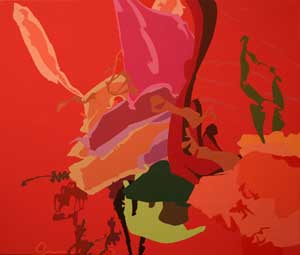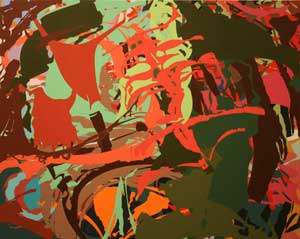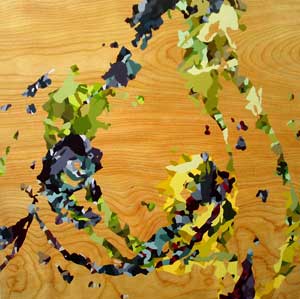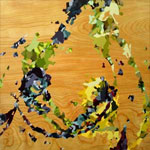I met the artist while he was a graduate student at the University of Texas at San Antonio and have followed his work ever since, although it hasn't always been an easy task, as he definitely prefers work over communication.
A quiet and steadfast painter, Tom Walsh has been painting under the radar far too long. I met the artist while he was a graduate student at the University of Texas at San Antonio and have followed his work ever since, although it hasn't always been an easy task, as he definitely prefers work over communication. In the beginning of November I tracked him down at the Menil Collection, where he works, and after a quick behind-the-scenes walk through of the Robert Gober exhibit, we ended up at his studio nestled within an interchange of highways and exit ramps in north downtown Houston. As expected, Walsh's studio was full of paintings.
Along two parallel walls hung at least a dozen paintings, with additional panels here and there, leaning up against the wall below. The wall at the entrance hung like a miniature retrospective, beginning with paintings I first fell in love with, moving through several different phases and ending with his newest works, which began to line the opposite wall. Stacked up in a corner I spied another set of paintings that Walsh assured me weren't worth display; yet snooping through them revealed much about his progression, influences, experiments and, in the artist's words, his desire for comic relief.
I was surprised by the amount of unpainted areas on the pictures surfaces. Walsh has consistently painted on wood panels, yet one would never know it from looking at his tightly configured screens of pattern and color that seem inherent to the picture planes. In this new series of paintings, Walsh is no longer interested in filling up the entire space as much as he is interested in the intricacies of his patterns and how they overlay the wood grain surface, all the while defying the appearance of being upon the surface. In fact, in many cases the painted space actually appears as if it were thinly incised into the wood panel itself. This balancing act is one of the artist's greatest talents; his ability to deny figure-ground relationships while inciting illusions of space keeps one perpetually engaged.

Walsh never intended to become an ‘abstract' painter; he attended the University of Houston (1992-1997) with the hopes of being a photo-realist painter. While pursuing that goal, the artist came to realize how abstract the process of photo-realist painting is and began investigating that process during in his junior year, studying with Derrick Boshier and Al Souza. Like all art students Walsh sat through many art history classes, some eye-opening some eye-closing. Of the eye-openers he pursued early 20 th century movements from the Vorticists (Britain's response to Cubism and Futurism, whose geometric breakdown of landscape and figure would greatly influence his later undergraduate work), to the Austrian Secessionists (Gustav Klimt, Egon Schiele) whose skillful compositions, and use of line and planar color he found truly inventive.
In his final years at UH, Walsh got the (as he puts it) “why” from Gail Stack and the “how” from Rachel Hecker, and began to play with perspective, macro and micro space, and applying patterns to objects like a skin, all of which lingered somewhere between figuration and abstraction. After graduation, Walsh rented a studio down the street from DiverseWorks and honed his craft by focusing on the presence of patterns themselves within a pictorial space, until they became patterns in space. These investigations led him to create almost flat paintings of monochrome patterns — checkerboards — using crisp lines and obfuscating scale, causing a major shift in his approach to painting as he entered graduate school.
A tip by Luis Jimenez led Walsh to join the MFA program at the UTSA, sharing studios with fellow then-students Augusto di Stefano, Andrea Caillouet, Kim Squaglia and Kate Terrell. Pivotal in his development were his two primary professors: Connie Lowe, whom he refers to as his mentor, and Frances Colpitt, considered his critical advisor, as well as visiting artists Mara Scrupe and Catherine Lee. From the interchange with his peers and mentors, the scale of his paintings grew and became more complicated. Beginning with his early forays into abstraction, where he “literally used outlines of figures as shapes … as a way of using organic shapes to break up inorganic patterns,” Walsh has consistently focused on the illusion of space in abstract painting. “I just have always liked the idea of shapes or series of shapes as flat planes. In illusionistically layering those planes, there is, for me at least, sort of a conundrum. I work as flatly as possible with my paint, and then I create a sense of space through overlapping. I can't explain it well, but in a petty way, it amuses me.”

Walsh sees his mature departure beginning at this point, with the employment of irregular shapes as layered planes, the significant influence of Asian pop culture and ink painting (in particular Japanese Kuniyoshi woodblock prints), and his desire to encapsulate a sense of movement in a static picture plane. Describing what he considers his “first” painting, the artist stated that “it appeared like a tornadic shape continuing beyond the framing edge.” In the subsequent paintings,Walsh continued to refine and complicate the picture plane, constantly initiating impossible spaces through his immaculate compositional strategies and challenging palette.
The new series of paintings find their lineage in the artist's previous body of work, with which I am most familiar. In a way these new paintings are like miniature versions of the larger paintings. Yet the artist isn't making physically smaller paintings. The intricate forms that embodied his surfaces are now fragmented and isolated, compressed and condensed into individual compositions that sporadically emerge across the picture plane. Compositionally he is still working with aspects of macro and micro space, yet here he appears to diminish the larger pattern to glorify one small section of a pattern/composition. For the artist, it is as if he blows up various compositional details only to scale them down and isolate them within the larger composition, each a complicated balance fused upon the picture plane.
Although Walsh spends all of his time either in his studio or at the Menil, he his well aware of and greatly fond of the ‘school' of ‘new' abstract painting, including Houston's own Aaron Parazette as well as painters Ingrid Calame, Monique Prieto, Kevin Appel, and Jeff Elrod. It is amongst this company that I see Walsh's work, as evidenced in his compositional ingenuity, imaginative palette and overall craftsmanship. Obviously, I'm a fan and maybe you will be too. Check out his show at SA's Cactus Bra gallery, otherwise you'll have to track him down in Houston, which isn't always easy. He's openly aware of his shyness, and talks about the irony of “breaking into” the Houston art scene — the city where he was born and raised, went to school, and lives and works. Laughing, the artist tells me about the numerous times he is asked where he is from, as if he just got to town.
Images courtesy the artist.
Jennifer Davy is an artist, writer, curator, currently living in San Antonio.




